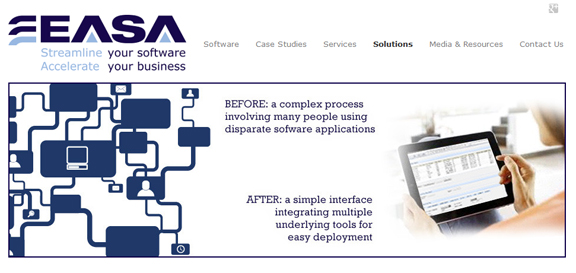
EASA Software offers a way to broaden the reach of simulation via expert-authored apps with simple GUIs.
January 23, 2015
 EASA Software offers a way to broaden the reach of simulation via expert-authored apps with simple GUIs.
EASA Software offers a way to broaden the reach of simulation via expert-authored apps with simple GUIs.Typically, Fred the CFD guy, Jane the FEA guru, or whoever happens to be the domain expert bears the brunt of the simulation workload. He or she is the one the rest of the engineers have come to rely on. Because setting up a problem in a general-purpose simulation software is too complex for regular designers and engineers, the experts find themselves running the same type of simulation jobs over and over, even if the input parameters vary very little from one job to another. The phenomenon they want to simulate may be relatively simple (say, the liquid flow inside a pipe or temperature rise inside a computer chassis). Yet, designers and engineers couldn’t define the problem on their own. The complexity of the simulation software stands in the way.
Some, however, have found a way to overcome the hurdle with expert-built apps. Many of EASA Software‘s customers take that approach.
Sebastian Dewhurst, EASA Software’s business development manager, said, “We have a lot of consulting activities. EASA was originally developed in response to customers’ requests to put a streamlined GUI front on complex CFD problems. So the GUI had to be built with simpler language. For example, instead of turbulence model, it would require blade angle for input. We gave the app just enough input fields so everyone could use it, but not so much that they risked exploding the model. That way, if they wanted to try something risky, they’d have to go see the expert.”
That was the birth of EASA version 1.0. Today, the company markets its solution as a “rapid application development platform.” The core component of the offering is the app authoring tool. Dewhurst said, “You don’t need to be a programming genius or an IT expert to author apps with EASA. This is designed for CAD and FEA experts.”
Most of EASA’s engineering customers use the software for onsite deployment. They rely on their own experts to build and deliver custom simulation apps—such as heat-exchanger or ball-bearing validation programs—for internal use. But Dewhurst revealed that the same method has been used by some customers in the financial sector to deliver SaaS offerings. He thinks an online marketplace for SaaS-style simulation apps built on EASA may broaden the reach of simulation.
Some, like Altair, has been testing the waters with a series of CFDCalc apps. The heat-sink calculator, SMX mixer (used in chemical industry), and other apps are available online and misleadingly easy to use. Yet, behind the scene, Altair’s powerful AcuSolve software (from ACCUSIM, acquired by Altair in 2012) is doing the number-crunching based on user input. The art of simplification occurs in the GUI, the interface that reduces the problem into a handful of input fields.
A profitable SaaS model for simulation apps is not out of the question, but vendors would have to first identify a series of commonly performed simulation jobs that can be offered for mass usage. SaaS commerce, after all, thrives on volume sales and affordable pricing—a dramatic departure from the current simulation vendors’ way of licensing that revolves around a select pool of enterprise clients with deep pockets.
For another approach on expert-built apps, read “COMSOL App Builder Set to Change How Experts Communicate Simulation to Others,” October 2014.
For examples of the type of apps you can build with EASA platform, visit EASA reseller FEA Solutions here.
Subscribe to our FREE magazine, FREE email newsletters or both!
About the Author
Kenneth Wong is Digital Engineering’s resident blogger and senior editor. Email him at [email protected] or share your thoughts on this article at digitaleng.news/facebook.
Follow DERelated Topics






